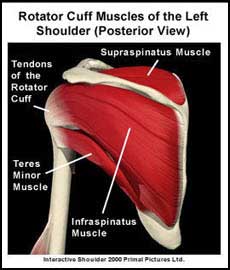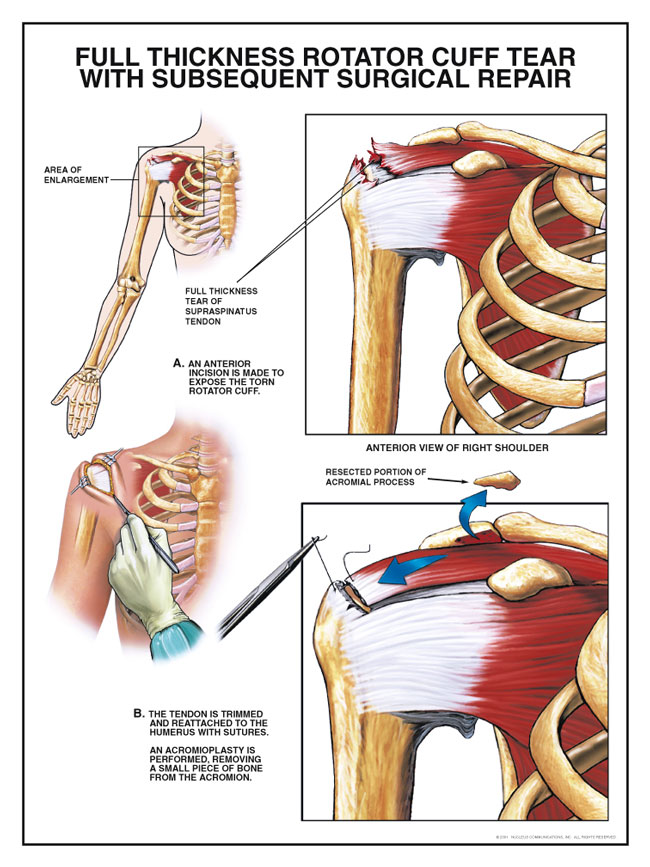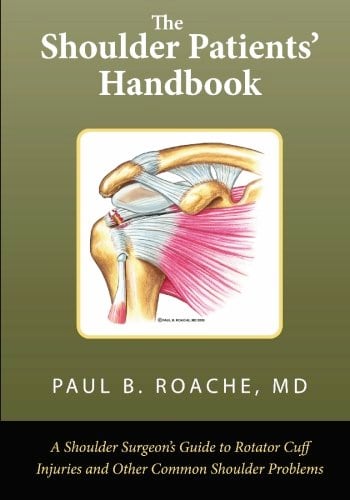In order to understand this condition, it is important to understand the anatomy and function of the shoulder. Please read Shoulder Pain Info’s section on basic shoulder anatomy. For additional background information on the biomechanics of the shoulder please read Shoulder Pain Info’s section on basic shoulder biomechanics.

What is the anatomy of rotator cuff?
The shoulder complex is made up of three bones, which are connected by muscles, ligaments, and tendons. The large bone in the upper arm is called the humerus. The shoulder blade is called the scapula and the collarbone is called the clavicle.
The top of the humerus is shaped like a ball. This ball sits in a socket on the end of the scapula. The ball is called the head of the humerus and the socket is called the glenoid fossa, hence the term “glenohumeral” joint. The glenoid fossa has a rim of tissue around it called the glenoid labrum. The glenoid labrum makes the glenoid fossa deeper.
Tendons connect muscles to bone. There are four muscles (supraspinatus, infraspinatus, subscapularis and teres minor) that surround the glenohumeral joint. These four muscles are attached to the scapula. They turn into tendons, which in turn attach to the humerus. The tendons of these four muscles make up the “rotator cuff” that blends into and helps support the glenohumeral joint capsule. The muscles of the rotator cuff and their tendons provide stability to the glenohumeral joint, the most mobile joint in the body.
What is a rotator cuff tear?
When the rotator cuff becomes injured or torn, it is described as a rotator cuff tear. These tears may be classified as partial-thickness tears or full-thickness tears. A partial-thickness rotator cuff tear is the term used when the tendon is not completely torn. A full-thickness rotator cuff tear is the term used when the tendon is completely torn.
What can cause a rotator cuff tear?
A rotator cuff tear may occur suddenly or develop gradually. Sudden rotator cuff tears usually occur during falls or while lifting heavy objects. A rotator cuff tear may develop gradually for a variety of reasons, including: :
– Repetitive overhead lifting.
– Degeneration of the rotator cuff due to aging.
– Poor blood supply to the rotator cuff.
– Narrowing of the space between the humerus and the acromion (subacromial arch). This can cause progressive “fraying” of the rotator cuff.
What does a rotator cuff tear feel like?
People with a rotator cuff tear may complain of any of the following:
– Pain in the shoulder during lifting and with overhead activities.
– Pain in the shoulder at night or while sleeping.
– Weakness in the shoulder, especially when attempting to lift the arm.
– Catching, grating or cracking sounds in the shoulder when the arm is moved.
– Limited motion.
Can a rotator cuff be detected on X-rays?
X-rays can rule out chips, cracks or other problems with bones but they can not identify soft tissue injuries like rotator cuff tears. In most cases special tests such as an arthrogram, diagnostic ultrasound or an MRI are required to determine if there is a tear in the rotator cuff.
A physician or physical therapist may use some of the following special tests to help diagnose a rotator cuff tear:
- Drop Arm Test
- Empty Can (Supraspinatus) Test
- Gerber’s Lift-Off Test
- Hawkins Test / Hawkins-Kennedy Impingement Test
- Neer Impingement Test
What is the treatment for a rotator cuff tear?
A lot can be done to help people who have torn their rotator cuff. A program of stretching and strengthening exercises, icing, pain medications, anti-inflammatory medications or a cortisone injection may decrease pain and improve function of the shoulder. Partial thickness tears usually respond to this type of treatment. Doctors and physical therapists who deal with people who have rotator cuff tears can help outline an individualized treatment program.
If the conservative approach to managing a rotator cuff tear is not effective, surgery may be required. An orthopaedic surgeon may be able to repair the rotator cuff through arthroscopic surgery or through an open shoulder procedure. Surgery is often required for full-thickness rotator cuff tears.

Nucleus Communications, Attribution, via Wikimedia Commons
What other information is available on rotator cuff tears?
A recommended books about rotator cuff injuries:

Treat Your Own Rotator Cuff
Treat Your Own Rotator Cuff is a complete program to prevent and rehabilitate rotator cuff injuries for athletes and non-athletes alike.

The Shoulder Patient’s Handbook: A Shoulder Surgeon’s Guide to Rotator Cuff Injuries and Other Common Shoulder Problems
Powerful Techniques to Relieve Shoulder Pain and Stiffness
Author Clair Davies’ own case of frozen shoulder led him to undertake an extensive study of trigger points and referred pain that eventually resulted in his best-selling Trigger Point Therapy Workbook.
